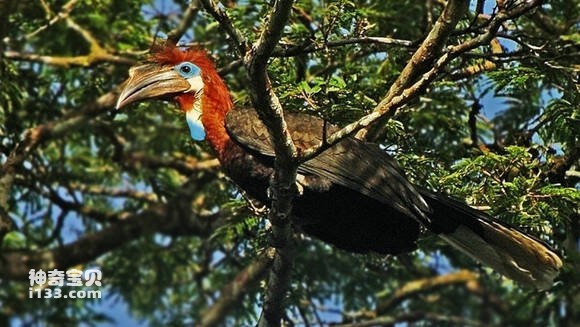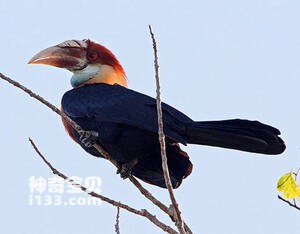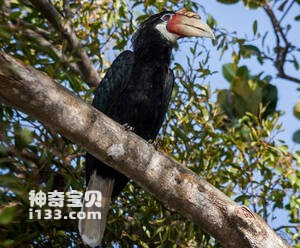
Ceratogymna atrata
Ceratogymna atrata,White-casqued Hornbill,Black-casqued wattled hornbill
Ceratogymna atrata, White-casqued Hornbill, Black-casqued wattled hornbill, ···

Rhyticeros cassidix
Rhyticeros cassidix,Aceros cassidix,Knobbedhornbill,Sulawesi wrinkled hornbill
Its scientific name is Rhyticeros cassidix, Aceros cassidix, foreign names K···

Aceros subruficollis
Aceros subruficollis,Rhyticeros subruficollis,Plain-pouched Hornbill
The species is known as Aceros subruficollis, Rhyticeros subruficollis, and ···

Rhyticeros everetti
Rhyticeros everetti,Aceros everetti,Everett's Hornbill,Sumba hornbill
The species is known by its scientific names Rhyticeros everetti and Aceros ···

Rhyticeros narcondami
Rhyticeros narcondami,Aceros narcondami,Narcondam Hornbill
Nargondam island crepe helmeted Hornbill scientific name Rhyticeros narconda···

Rhyticeros plicatus
Rhyticeros plicatus,Aceros plicatus,Blyth's Hornbill,Papuan hornbill
Rhyticeros plicatus, Aceros plicatus, foreign names Blyth's Hornbill, Pa···

Rhabdotorrhinus exarhatus
Rhabdotorrhinus exarhatus,Penelopides exarhatus,Sulawesi Hornbill
The species' scientific names are Rhabdotorrhinus exarhatus, Penelopides···

Rhabdotorrhinus leucocephalus
Rhabdotorrhinus leucocephalus,Aceros leucocephalus,Writhed Hornbill
The species is known as Rhabdotorrhinus leucocephalus, Aceros leucocephalus ···

Aceros waldeni
Aceros waldeni,Rhabdotorrhinus waldeni,Writhe-billed Hornbill,Walden's hornbill,Visayan wrinkled hornbill,Rufous-headed hornbill
Aceros waldeni, Rhabdotorrhinus waldeni, The names Writhe-billed hornbill, W···

Aceros corrugatus
Aceros corrugatus,Rhabdotorrhinus corrugatus,Wrinkled hornbill,Sunda wrinkled hornbill
The Sunda Wrinkled hornbill (Aceros corrugatus, Rhabdotorrhinus corrugatus, ···

Penelopides mindorensis
Penelopides mindorensis,Mindoro hornbill
Mindoro hornbill's scientific name is Penelopides mindorensis, foreign n···

Penelopides panini
Penelopides panini,Rufous-tailed Hornbill,Visayan hornbill
The Visayan hornbill is known as Penelopides panini, Rufous-tailed hornbill ···

Penelopides samarensis
Penelopides samarensis,Samar hornbill,Samar tarictic hornbill
Samar hornbill scientific name Penelopides samarensis, foreign names Samar h···

Penelopides affinis
Penelopides affinis,Mindanao tarictic hornbill,Mindanao hornbill
Mindanao hornbill scientific name Penelopides affinis, foreign names Mindana···

Penelopides manillae
Penelopides manillae,Luzon Hornbill
The scientific name of Luzon Hornbill is Penelopides manillae and its foreig···

Berenicornis comatus
Berenicornis comatus,White-crowned hornbill,Long-crested hornbill
The scientific name of the White-crowned hornbill is Berenicornis comatus, a···

Anorrhinus tickelli
Anorrhinus tickelli,Rusty-cheeked hornbill,Tickell's brown hornbill
The species is known as Anorrhinus tickelli, rust-cheeked hornbill and Ticke···

Anorrhinus galeritus
Anorrhinus galeritus,Bushy-crested hornbill
Scientific name Anorrhinus galeritus, foreign name Bushy-crested hornbill, t···

Rhinoplax vigil
Rhinoplax vigil,Helmeted Hornbill,Buceros vigil
The scientific names of Helmeted Hornbill are Rhinoplax vigil, Helmeted Horn···

Buceros hydrocorax
Buceros hydrocorax,Rufous hornbill
Buceros hydrocorax, also known as Rufous hornbill, is a bird of the genus Ho···

Buceros rhinoceros
Buceros rhinoceros,Rhinoceros Hornbill
Buceros rhinoceros and Rhinoceros Hornbill have three subspecies (1. Buceros···
